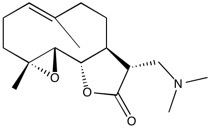DMAPT | NFkB inhibitor
NMR (Conforms)

Available Options
| Size : | Price | Quantity | |
|---|---|---|---|
| 5 mg | $50.00 | ||
| 25 mg | $175.00 |
DMAPT (870677-05-7) is a water soluble analog of the natural plant product parthenolide (Cat.# 10-2096) which suppresses in vivo tumor growth of two tobacco-associated neoplasms, lung and bladder cancer. It inhibits NFκB and stimulates the formation of reactive oxygen species which induced the activation of JNK.1 In non-small cell lung cancers DMAPT inhibits NFκB and DNA double-strand break repair.2
References/Citations:
1) Shanmugam et al. (2011), A water soluble parthenolide analog suppresses in vivo tumor growth of two tobacco-associated cancers, lung and bladder cancer, by targeting NFκB and generating reactive oxygen species; Int. J. Cancer, 128 2481
2) Estrabrook et al. (2011), Inhibition of NF-κB and DNA double-strand break repair by DMAPT sensitizes non-small-cell lung cancers to X-rays; Free Radic. Biol. Med., 51 2249
NMR (Conforms)
Safety Data Sheet:
Product Data Sheet:
Materials provided by Focus Biomolecules are for laboratory research use only and are not intended for human or veterinary applications. Please note that we do not sell to individuals and that all orders placed by non-research organizations will incur a $20 restocking/refund fee
DMAPT (870677-05-7) is a water soluble analog of the natural plant product parthenolide (Cat.# 10-2096) which suppresses in vivo tumor growth of two tobacco-associated neoplasms, lung and bladder cancer. It inhibits NFκB and stimulates the formation of reactive oxygen species which induced the activation of JNK.1 In non-small cell lung cancers DMAPT inhibits NFκB and DNA double-strand break repair.2
References/Citations:
1) Shanmugam et al. (2011), A water soluble parthenolide analog suppresses in vivo tumor growth of two tobacco-associated cancers, lung and bladder cancer, by targeting NFκB and generating reactive oxygen species; Int. J. Cancer, 128 2481
2) Estrabrook et al. (2011), Inhibition of NF-κB and DNA double-strand break repair by DMAPT sensitizes non-small-cell lung cancers to X-rays; Free Radic. Biol. Med., 51 2249
Related NFκB Products
Download
Calculate the molar concentration, mass or volume in a solution.
Concentration × Volume × Molecular Weight = Mass
Focus Biomolecules • Plymouth Meeting, PA USA • 1-855-FOCUS21
Focus Biomolecules
Plymouth Meeting, PA USA
1-855-FOCUS21
Website Created by Advanta Advertising LLC.

